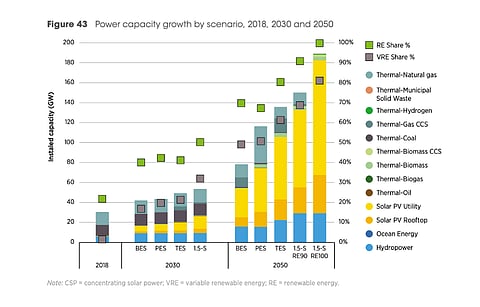

The International Renewable Energy Agency (IRENA) calls solar PV a 'no-regrets option' for Malaysia in all the scenarios it envisions for the country's energy transition in a new report, with potential to install 153 GW of this clean energy technology by 2050, regardless of its renewable energy ambition, supported by 782 GWh of storage.
It factors in wide availability of solar resource and land to peg 153 GW PV capacity largely located in and around key demand centers which can be realized if the country installs 4.3 GW annually. In the short-term, IRENA wants Malaysia to start with 1.4 GW annual deployments until 2030 to achieve more than 17 GW annual capacity for an investment of $10.8 billion.
At the end of 2021, Malaysia's total grid connected power generation capacity was 33 GW largely dominated by coal and natural gas. Solar PV's share at the end of 2018 was around 400 MW. The government wants to continue building more gas-fired plants to replace aging coal and gas facilities while targeting an installed renewable energy capacity of 40% by 2035. But it can do more to ensure local, affordable and clean energy, according to IRENA.
Its report Malaysia Energy Transition Outlook estimates 3 scenarios to ascertain its decarbonization pathway. The 2 scenarios of 1.5-S RE100 and 1.5-S RE90 entail between 103 GW and 153 GW of installed solar PV capacity along with 36 GW of other renewables, supported by 20 GW of energy storage.
"Solar PV is a key technology, and given its modularity and low costs, as well as the rich national resource base of Malaysia, it plays a key role regardless of ambition level. However, it would require careful operational planning and ancillary service provision to integrate effectively," reads the report.
Under the Baseline Energy Scenario (BES), by 2050 the total capacity of solar PV reaches 39 GW, representing a generation capacity share of 49%. For the other scenarios, the solar PV capacity reaches 59 GW in the Planned Energy Scenario (PES) (51% capacity share), and 83 GW in the Transforming Energy Scenario (TES) (61% capacity share).
In the 1.5-S RE90 or 1.5°C scenario with 90% renewable energy generation and 1.5-S RE100 that envisions 1.5°C 100% renewable energy generation scenario, installed solar PV capacity will vary between 103-153 GW (between 69% to 81% capacity shares).
IRENA says its research offers a long-term energy pathway to a cleaner and more sustainable energy system for the country. To get there, it needs to reduce government spending on fossil-fuel related subsidies and strengthen the capacity of national financing institutions and provide an ecosystem for renewable energy investment.
"Through strategy and policies that prioritize clean energy investments and are consistent at all government levels, Malaysia can achieve its renewed ambition of reaching net zero by 2050, while securing a more prosperous, sustainable future for its people," said IRENA Director-General, Francesco La Camera.
Renewable energy can help Malaysia cushion itself from volatile international gas and oil markets to import energy. According to IRENA, for Malaysia it is cheaper to switch over to renewables to meet the increasing demand for energy which will increase their total share to over half of its energy mix by 2050. Currently it stands at 5%.
Analysts offer 4 recommendations to accelerate energy transition in Malaysia, namely development of cohesive and integrated long-term energy planning strategies, creating regulatory and legal frameworks, investing in technology and innovation and financing.
Complete report can be downloaded for free from IRENA's website.
.png?w=50&fm=png)